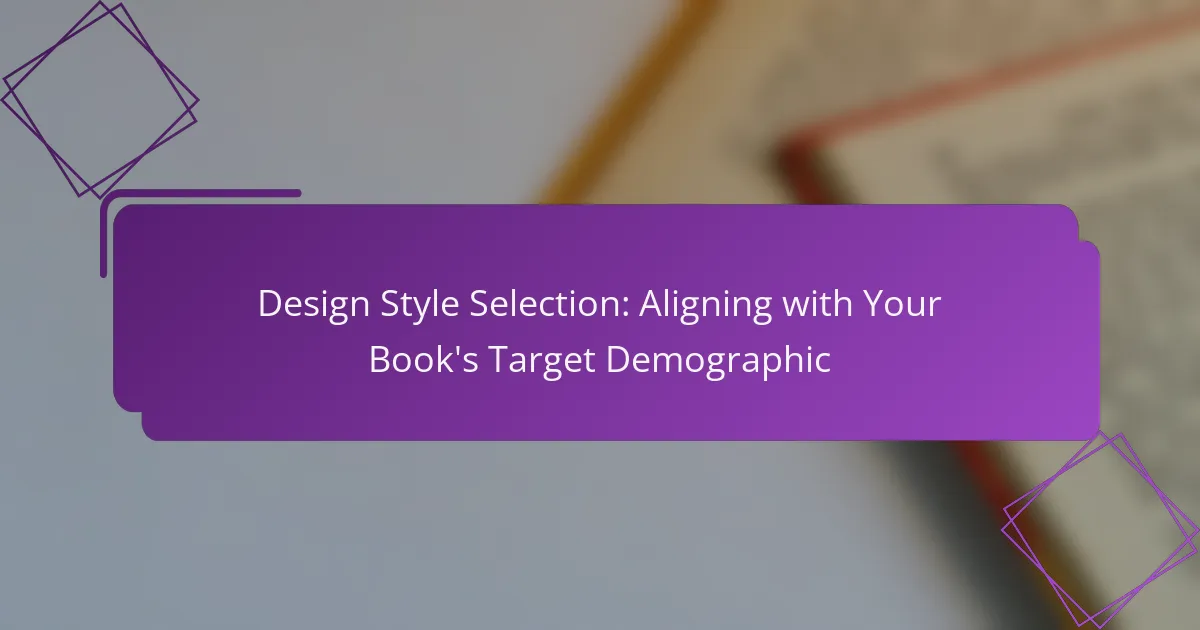Selecting the right design style for your book is crucial for connecting with your target demographic. By understanding their preferences and current market trends, you can create a visual identity that resonates with readers and enhances their overall experience. A thoughtful design not only captures attention but also influences how your content is perceived and engaged with.
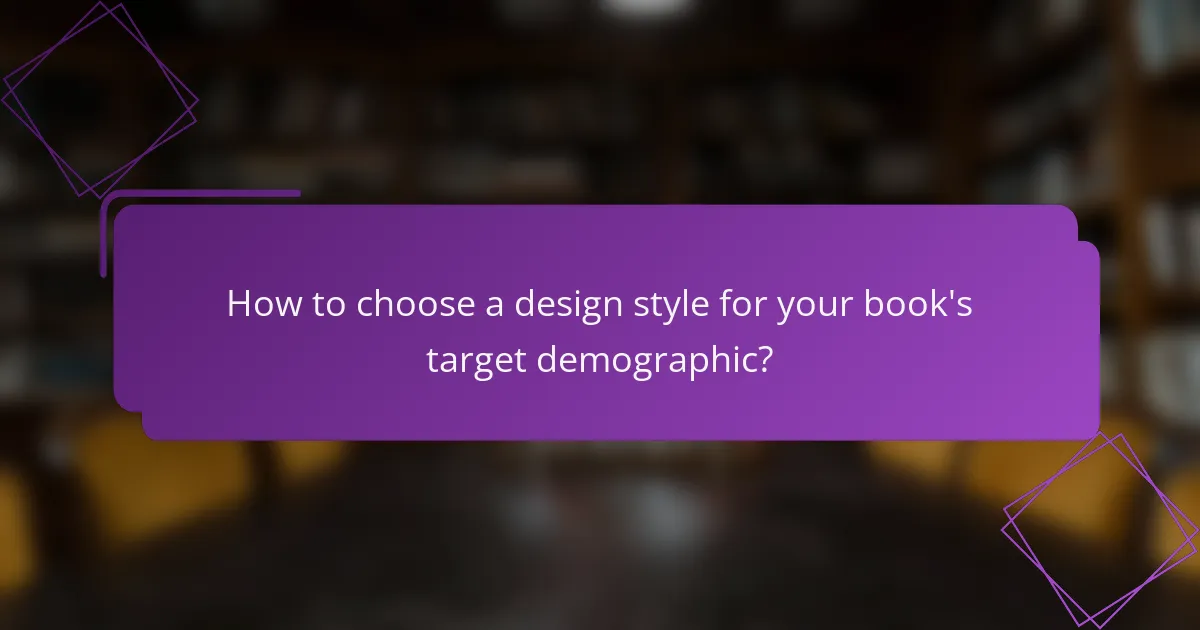
How to choose a design style for your book’s target demographic?
Choosing a design style for your book’s target demographic involves understanding their preferences, analyzing current market trends, and considering the aesthetics specific to your genre. This alignment ensures that your book resonates with readers and stands out in a competitive market.
Identify target audience preferences
Understanding your target audience’s preferences is crucial for selecting an effective design style. Conduct surveys or focus groups to gather insights on what appeals to your demographic, such as color schemes, typography, and imagery. For example, younger readers might prefer bold, vibrant designs, while older audiences may favor more classic and subdued aesthetics.
Utilize social media platforms and online forums to observe discussions and trends among your target readers. Engaging with your audience directly can provide valuable feedback that informs your design choices.
Analyze market trends
Keeping an eye on market trends helps you understand what design styles are currently popular within your genre. Browse bestseller lists and examine the covers of top-selling books to identify common elements that attract readers. This can include layout styles, graphic elements, and overall visual themes.
Consider subscribing to industry newsletters or following design blogs that focus on book publishing. These resources often highlight emerging trends and successful design strategies that can inspire your own book’s style.
Consider genre-specific aesthetics
Each genre has its own visual language that resonates with its audience. For instance, fantasy novels often feature intricate illustrations and mystical fonts, while thrillers may utilize stark, bold designs with dark color palettes. Understanding these genre-specific aesthetics can guide your design choices effectively.
Review genre conventions and analyze successful books within your category to determine what works. This will help you create a design that not only attracts your target demographic but also meets their expectations for that genre.
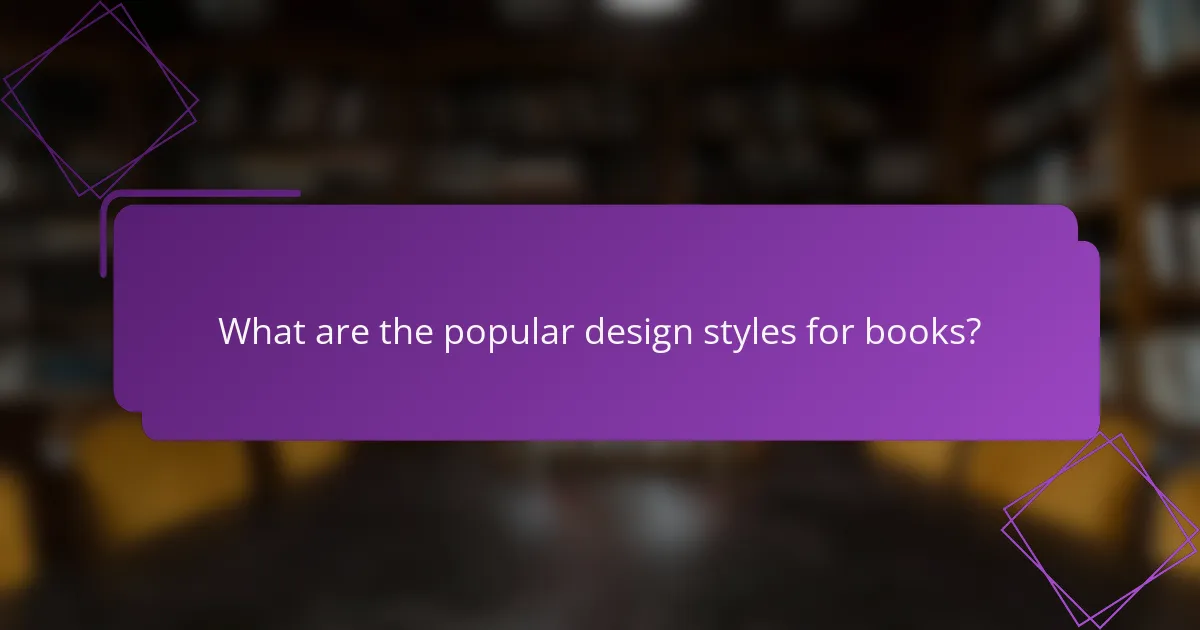
What are the popular design styles for books?
Popular design styles for books include minimalist, vintage, and modern typography. Each style caters to different target demographics, influencing how readers perceive and engage with the content.
Minimalist design
Minimalist design focuses on simplicity and functionality, often using ample white space and limited color palettes. This style appeals to readers who appreciate clean aesthetics and straightforward navigation.
When implementing minimalist design, prioritize essential elements and eliminate unnecessary distractions. Use clear fonts and concise layouts to enhance readability and maintain a professional appearance.
Vintage design
Vintage design evokes nostalgia through classic typography, ornate illustrations, and earthy color schemes. This style resonates with audiences who enjoy historical themes or retro aesthetics.
To effectively use vintage design, incorporate elements like decorative fonts and textured backgrounds. Ensure that the design aligns with the book’s content and target demographic to create a cohesive experience.
Modern typography
Modern typography emphasizes innovative font choices and creative layouts, appealing to contemporary readers. This style often includes bold typefaces and dynamic arrangements that draw attention to key messages.
When selecting modern typography, consider legibility and brand identity. Experiment with font pairings and sizes to create visual interest while maintaining clarity. Avoid overly complex designs that may confuse readers.

How does design impact reader engagement?
Design significantly influences reader engagement by capturing attention and enhancing the overall reading experience. A well-thought-out design can make content more accessible and enjoyable, leading to increased retention and interaction.
Visual appeal increases interest
Visual elements such as color schemes, typography, and layout play a crucial role in attracting readers. A striking cover design or an engaging interior layout can draw potential readers in, making them more likely to explore the content. For instance, using bright colors and dynamic images can evoke emotions and create a sense of excitement.
Consider the target demographic when selecting visual styles. For younger audiences, bold and modern designs may resonate better, while older readers might prefer classic and understated aesthetics. Testing different designs with focus groups can provide valuable insights into what appeals to your specific audience.
Brand identity reinforcement
Consistent design elements help reinforce your brand identity, making your book recognizable and memorable. This includes using specific fonts, colors, and imagery that align with your brand’s message and values. For example, a book about sustainability might use earthy tones and recycled paper to reflect its commitment to the environment.
Ensure that your design choices are coherent across all platforms, from the book cover to promotional materials. This consistency builds trust and familiarity with your audience, encouraging them to engage with your content and share it with others. Avoid drastic changes in design that could confuse or alienate your readers.

What tools can help in selecting design styles?
Several tools can assist in selecting design styles that resonate with your book’s target demographic. These tools provide templates, layout options, and inspiration to help you create a visually appealing product that aligns with your audience’s preferences.
Canva for templates
Canva is a user-friendly graphic design platform that offers a wide range of templates tailored for various book genres. You can easily customize these templates with your content, colors, and fonts, making it a practical choice for authors looking to create professional-looking designs without extensive design skills.
When using Canva, consider the genre of your book. For example, a romance novel might benefit from softer colors and elegant fonts, while a thriller could use bold typography and darker themes. Always ensure that the chosen template aligns with your target audience’s expectations.
Adobe InDesign for layout
Adobe InDesign is a powerful tool for creating complex layouts and is ideal for authors who want complete control over their book’s design. It allows for precise adjustments to text and images, ensuring that your layout is not only visually appealing but also functional.
When working in InDesign, focus on maintaining a consistent style throughout your book. Use grids and guides to align elements properly, and pay attention to typography settings to enhance readability. This tool is particularly beneficial for print books where layout precision is crucial.
Behance for inspiration
Behance is a platform where designers showcase their work, making it a valuable resource for finding design inspiration. By browsing through various projects, you can discover trends and styles that resonate with your target demographic.
To effectively use Behance, search for projects in your book’s genre or related fields. Take note of color schemes, typography, and layout styles that catch your eye. This can inform your design choices and help you create a book that stands out in a crowded market.
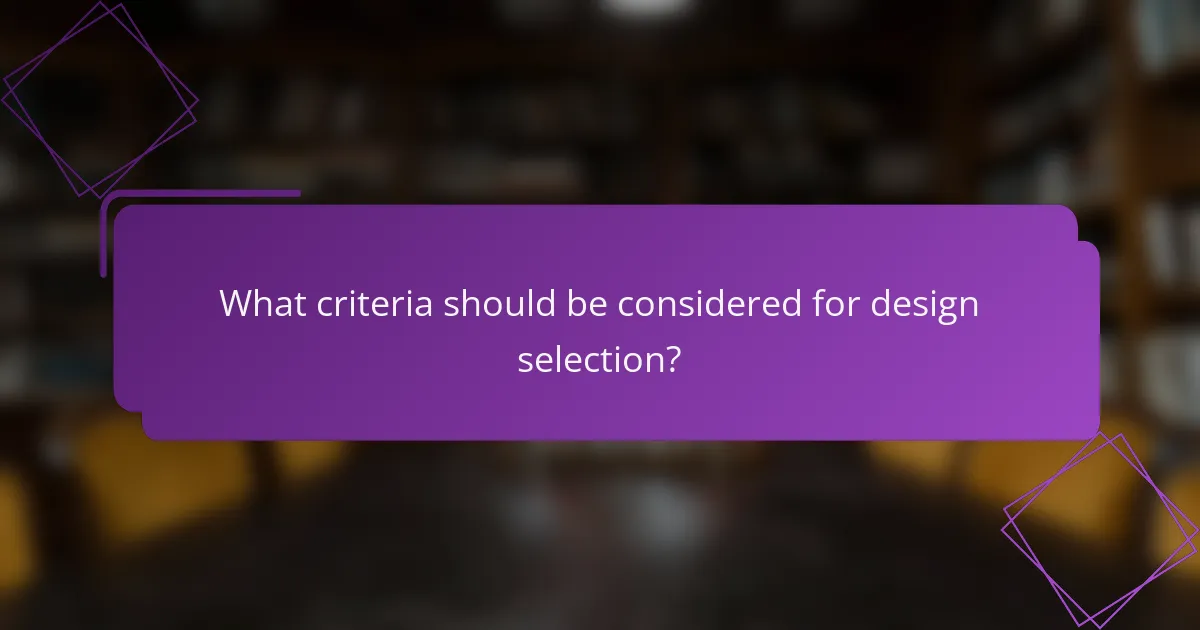
What criteria should be considered for design selection?
When selecting a design style for your book, consider factors such as your target demographic, budget constraints, and production capabilities. These criteria will help ensure that your design resonates with readers while remaining feasible to produce.
Target demographic analysis
Understanding your target demographic is crucial for effective design selection. Analyze the age, interests, and preferences of your intended audience to choose a style that appeals to them. For instance, a children’s book may benefit from bright colors and playful fonts, while a thriller might require a darker, more sophisticated aesthetic.
Conduct surveys or focus groups to gather insights about your audience’s design preferences. This data can guide your choices and help avoid misalignment with reader expectations.
Budget constraints
Your budget plays a significant role in determining the design style you can implement. High-quality illustrations and professional layouts can be costly, so it’s essential to establish a clear budget early in the process. Aim for a balance between quality and affordability to maximize your investment.
Consider allocating funds for essential design elements first, such as cover art and typography, before exploring additional features like custom illustrations. Prioritize spending on aspects that will have the most significant impact on your book’s appeal.
Production capabilities
Assess your production capabilities to ensure your design choices are practical. Different printing methods and materials can affect the final look of your book, so select a design that aligns with what your printer can deliver. For example, intricate designs may not translate well to lower-quality printing.
Consult with your printer about their capabilities and limitations. This collaboration can help you avoid costly revisions and ensure that your design vision is achievable within your production framework.
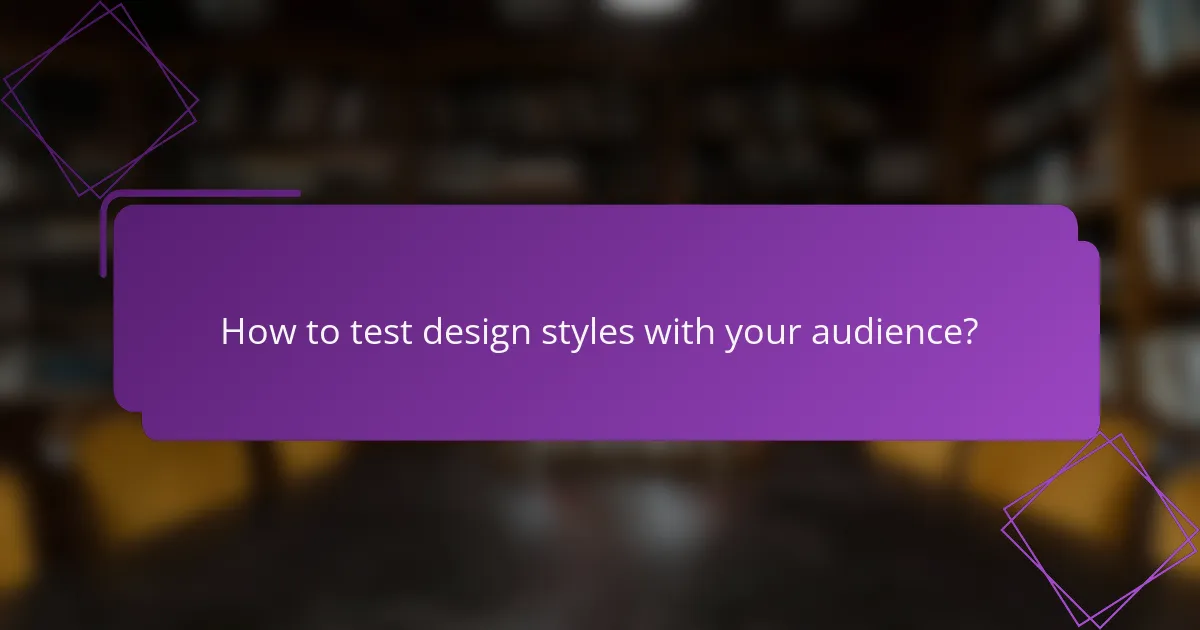
How to test design styles with your audience?
Testing design styles with your audience involves gathering direct feedback to understand their preferences and reactions. This can be achieved through various methods like focus groups and surveys, which provide insights into what resonates with your target demographic.
Focus groups for feedback
Focus groups are small, diverse groups of individuals from your target audience who discuss their perceptions of different design styles. This qualitative method allows for in-depth conversations, revealing not only preferences but also the reasons behind them.
When organizing a focus group, aim for 6-10 participants to encourage interaction while keeping discussions manageable. Prepare specific questions about design elements and observe body language and reactions to gauge genuine responses.
Surveys for preferences
Surveys are an effective way to collect quantitative data on design style preferences from a larger audience. They can include multiple-choice questions, rating scales, and open-ended responses to capture a wide range of opinions.
To maximize response rates, keep surveys concise, ideally under 10 minutes. Use clear language and avoid jargon. Consider offering a small incentive, such as a discount or entry into a prize draw, to encourage participation.
